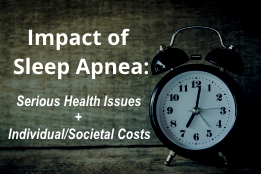Cost of Sleep Apnea
Millions of adults worldwide have obstructive sleep apnea (OSA), but only 20 percent are diagnosed and treated. OSA is a serious condition that deprives your body of oxygen. It happens when soft tissue blocks your airway while sleeping. Individuals with sleep apnea may stop breathing 20 to 60 times per hour, which leads to serious health issues.

People with OSA suffer from short-term problems, such as excessive daytime sleepiness, irritability, difficulty concentrating, and depression. Yet, the long-term impact of sleep apnea can be life threatening and includes increased risk for cardiovascular disease, stroke and diabetes.
In addition to dangerous health concerns, moderate-to-severe OSA carries significant economic cost to individuals and society. For example, to treat all people in the U.S. with OSA, the total cost can range from $65 billion to $165 billion per year.
Cost of Sleep Apnea Diagnosis and Treatment
The majority of medical costs for OSA are driven by diagnosis expenses and funding the first year of treatment. Approximately $12.4 billion is spent annually on diagnosing and treating sleep apnea for 5.9 million U.S. adults.
An overnight sleep apnea test called a polysomnography, which is administered in a hospital or clinical setting, is the most common type of sleep study to diagnosis the condition. Yet, less-expensive home sleep tests that are overseen by a healthcare provider are growing in use and shown to be effective in diagnosing the condition.
A sleep apnea machine for CPAP therapy, which stand for continuous positive airway pressure, is the most commonly used treatment. During sleep, a CPAP machine pumps an ongoing flow of air into an individuals lungs. This prevents airways from collapsing so breathing is uninterrupted throughout the night – and quality sleep is achieved.
In addition to CPAP therapy, mouthguards are sometimes used to treat OSA. In special circumstances, healthcare providers may recommend surgery to patients to address the condition.
Hidden Healthcare Costs
Individuals who avoid getting diagnosed and treated for OSA will likely develop one or more of the health issues described above. As a result, treating these conditions increases the overall cost of healthcare.
One study reported an annual healthcare-use cost of $2,720 for OSA patients prior to diagnosis, compared to $1,384 among matched control subjects. Another study found people who quit using their CPAP therapy for 30 days were three times more likely to be readmitted to the hospital for any cause within a month.
Treating sleep apnea can reduce a person’s risk for associated health conditions and, in turn, avoid expensive health costs.
Other Lifestyle Costs
In addition to health-related costs, untreated sleep apnea can lead to increased expense in the workplace, traffic-related accidents, and other societal implications. Consider the following.
Workplace Impact: People with untreated OSA have more absences and are less productive while at work because of drowsiness associated with the condition. In addition, those who do not manage their sleep apnea are twice as likely to get injured on the job. Undiagnosed and untreated OSA totals $6.5 billion in workplace costs.
Yet, research shows that those who regularly use CPAP therapy are 27.3 percent more productive and miss 1.8 fewer days of work per year when compared to those not receiving treatment for their OSA.
Traffic Accidents: Because of poor sleep, people with untreated OSA have an increased accident rate between three and seven times that of the general population. Yet, these rates fall to normal levels after successful CPAP therapy.
Undiagnosed OSA is a major contributing factor in traffic collision costs and reached $26.2 billion annually in recent years. Drowsy driving causes nearly 29 percent of crashes.
Lifestyle Impact: Data reveals that those with untreated sleep apnea experience significantly poorer vitality and well-being. In addition, the divorce rate can be up to three times higher among those with unmanaged OSA.
Those who treat their condition have shown to consume 31 percent fewer alcoholic drinks, smoke 62 percent fewer cigarettes, and take 21 percent fewer sleeping pills. A study showed that 78 percent of patients who receive sleep apnea treatment say it is a good investment for them.
To learn more about sleep apnea and its treatment, please see the articles listed below.
About the Author: This article was written by sleep expert Alex Deckard of Aeroflow Healthcare, a provider of sleep apnea machines, masks and supplies.
Sources:
http://www.who.int/gard/publications/chronic_respiratory_diseases.pdf
https://sleep.med.harvard.edu/file_download/100
https://aasm.org/resources/pdf/sleep-apnea-economic-crisis.pdf
https://www.sciencedirect.com/science/article/pii/S2095881115300081
http://www.hmenews.com/article/new-study-links-non-adherence-cpap-therapy-hospital-readmissions
Related Information - Cost of Sleep Apnea
Sleep Apnea: A Primer
More About Sleep Apnea
Watch for These Apnea Symptoms
Causes of Sleep Apnea
Apnea Treatments
Sleep Apnea Machine
Sleep Apnea Test
Can Sleep Apnea Cause Death?
Sleep Apnea and Cancer Link
Sleep Apnea in Children
Weight Gain and Sleep Apnea
What is Sleep Apnea - Sleep Study
Tips on Buying CPAP Equipment Online
When to Replace CPAP Supplies
Share Sleep Tips Do you have a great tip to share with others who are struggling with sleep? What works for you might help someone else. |



